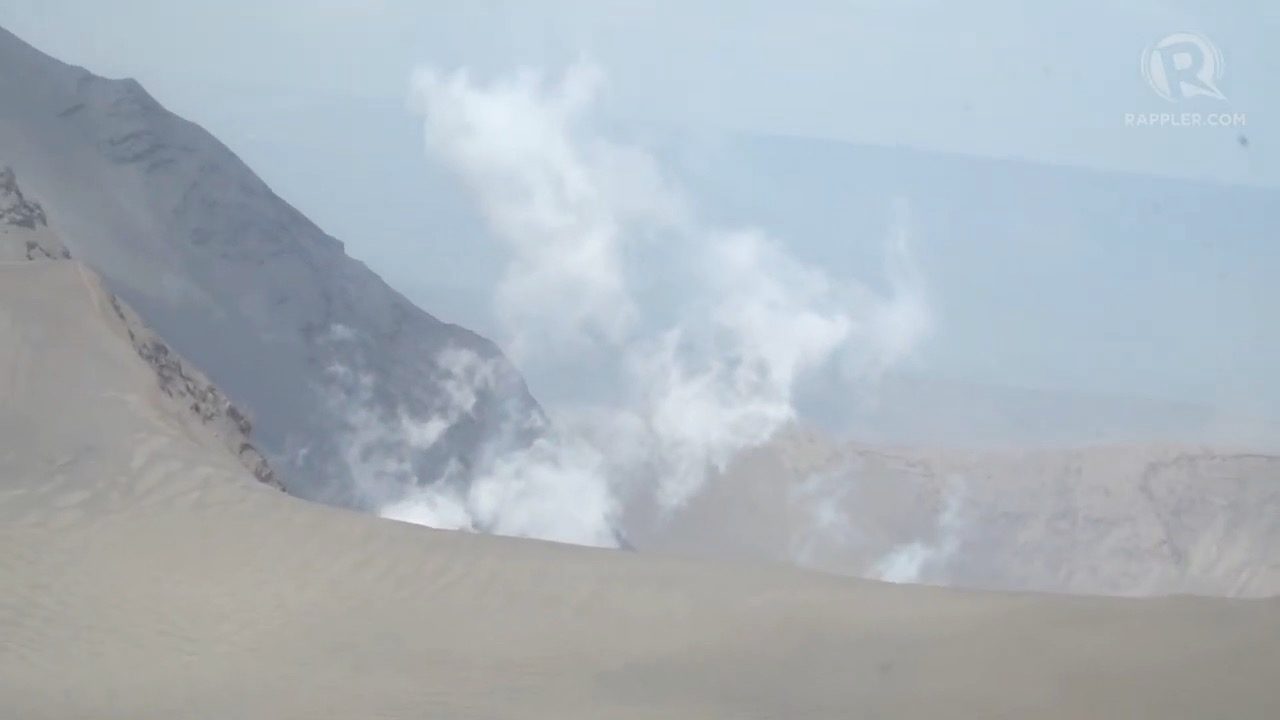SUMMARY
This is AI generated summarization, which may have errors. For context, always refer to the full article.

MANILA, Philippines (UPDATED) – State volcanologists maintained Alert Level 4 for Taal Volcano in the province of Batangas on Saturday, January 18, which means a hazardous eruption could still occur “within hours to days.”
The Philippine Institute of Volcanology and Seismology (Phivolcs) said magma is still rising within Taal, as indicated by persistent volcanic earthquakes. (READ: Taal Volcano’s 2020 eruption: What we know so far)
“Habang may paggalaw ng magma, ibig sabihin hindi pa talaga siya humuhupa (While there’s still magmatic intrusion, that means the situation has not yet eased),” said Phivolcs Director Renato Solidum Jr in a press briefing on Saturday morning.
Solidum also explained that two monitoring networks are now being used for volcanic earthquakes – the Philippine Seismic Network which covers the whole country, and the Taal Volcano Network.
The Taal Volcano Network stopped operations Sunday, January 12, when Taal started erupting, until Monday, January 13. Then it was revived starting Tuesday, January 14.
“Pero hindi po tayo nawalan ng pagbabantay sa bulkan kasi ‘yung Philippine Seismic Network…marami po tayong malalapit na sensors sa paligid ng Batangas, at ito po ‘yung ginamit natin,” added Solidum.
(But we did not lose seismic monitoring for the volcano since the Philippine Seismic Network has many sensors close to Taal in the Batangas area, and we used that network.)
In its 6 pm update on Saturday, Phivolcs said the Philippine Seismic Network has plotted 673 volcanic earthquakes since 1 pm last Sunday. Of these, 175 were felt with intensities ranging from Intensity I to V.
Just from 5 am to noon on Saturday – a 7-hour period – there were 13 volcanic earthquakes plotted.
Meanwhile, the Taal Volcano Network, which Phivolcs said includes small earthquakes undetectable by the Philippine Seismic Network, recorded 366 volcanic earthquakes just from 5 am to 4 pm on Saturday. Of these, 3 were tremor events and 8 were low-frequency earthquakes.
“‘Pag tremor po, mahaba pong paggalaw ng ilalim na tuloy-tuloy…. ‘Yung low-frequency earthquake, ito naman po ay gumagalaw din ang magma pero hindi tuloy-tuloy,” Solidum had said on Saturday morning.
(During tremors, the shaking beneath is continuous. During low-frequency earthquakes, magma is also moving but the vibrations are not prolonged.)
Phivolcs reiterated in its update that “such intense seismic activity likely signifies continuous magmatic intrusion beneath the Taal edifice, which may lead to further eruptive activity.”
As for the volcano’s main crater, it continues “weak emission” of plumes.
“Since 8 am this morning, Taal Volcano’s activity has been generally characterized by weak emission of steam-laden plumes 500 to 800 meters high from the main crater that drifted to the general southwest. A total of two discrete weak ash explosions were observed,” Phivolcs said.
“Latest sulfur dioxide (SO2) emission was measured at an average of 1,442 tons per day today at 5 pm,” the agency added.
If a hazardous eruption occurs, Alert Level 5 – the highest – would be raised. This may or may not happen. (READ: TIMELINE: Taal Volcano eruptions since 1572)
Phivolcs stressed that there must be “total evacuation” of Taal Volcano Island as well as high-risk areas within a 14-kilometer radius from the main crater and “along the Pansipit River Valley where fissuring has been observed.” (WATCH: Fishermen risk lives for catch around restive Taal Volcano)
Fissuring means cracks were seen on the ground in parts of Batangas province, particularly in the towns of Lemery, Agoncillo, Talisay, and San Nicolas, which are all high-risk areas.
Phivolcs earlier explained that ground deformation indicates magma is rising at Taal.
At least 11 towns in Batangas are under complete lockdown to prevent residents from returning to their homes.
More than 16,000 families or over 70,000 persons are staying in evacuation centers, according to the National Disaster Risk Reduction and Management Council.
Aside from government assistance, there are relief efforts by local companies and some countries have offered aid.
So far, the cost of agricultural damage is pegged at P3.06 billion. Ashfall destroyed various crops in Batangas and in the neighboring provinces of Cavite and Laguna. (READ: How to stay safe during volcanic ashfall)
Both Batangas and Cavite are under a state of calamity. (IN PHOTOS: ‘We will rise’) – Rappler.com
Add a comment
How does this make you feel?





There are no comments yet. Add your comment to start the conversation.